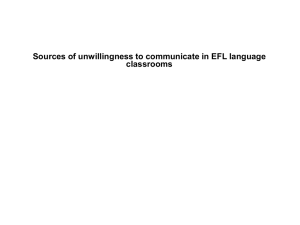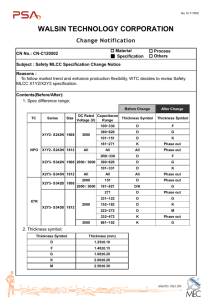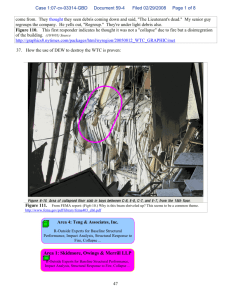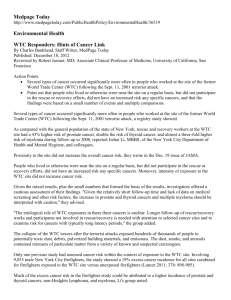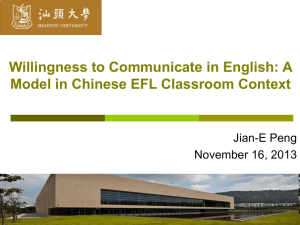Willingness to Communicate in an L2 and Integrative Motivation
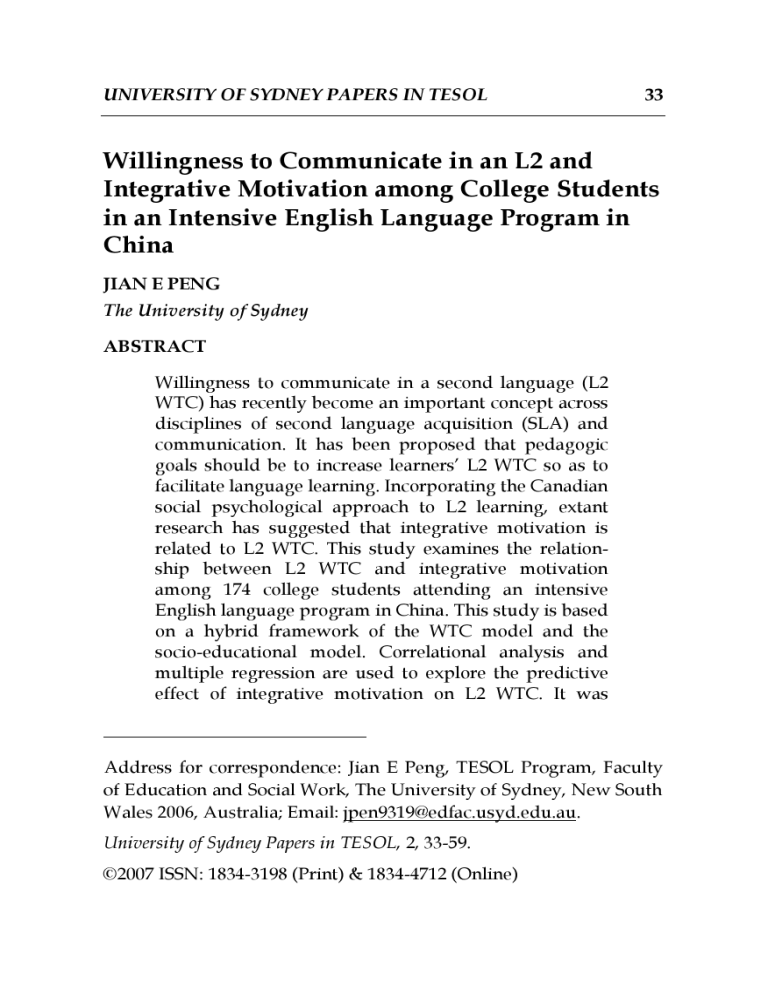
UNIVERSITY OF SYDNEY PAPERS IN TESOL 33
Willingness to Communicate in an L2 and
Integrative Motivation among College Students in an Intensive English Language Program in
China
JIAN E PENG
The University of Sydney
ABSTRACT
Willingness to communicate in a second language (L2
WTC) has recently become an important concept across disciplines of second language acquisition (SLA) and communication. It has been proposed that pedagogic goals should be to increase learners’ L2 WTC so as to facilitate language learning. Incorporating the Canadian social psychological approach to L2 learning, extant research has suggested that integrative motivation is related to L2 WTC. This study examines the relationship between L2 WTC and integrative motivation among 174 college students attending an intensive
English language program in China. This study is based on a hybrid framework of the WTC model and the socio-educational model. Correlational analysis and multiple regression are used to explore the predictive effect of integrative motivation on L2 WTC. It was
Address for correspondence: Jian E Peng, TESOL Program, Faculty of Education and Social Work, The University of Sydney, New South
Wales 2006, Australia; Email: jpen9319@edfac.usyd.edu.au.
University of Sydney Papers in TESOL , 2, 33-59.
©2007 ISSN: 1834-3198 (Print) & 1834-4712 (Online)
34 Jian E Peng found that integrative motivation accounted for a small proportion of variation in L2 WTC. Motivation was the strongest predictor of L2 WTC, while attitudes towards the learning situation did not predict L2 WTC. The limitations of the study and implications for future research are addressed.
INTRODUCTION
Modern language teaching and learning has emphasised the significance of cultivating communicative competence in second language (L2) learners (Canale & Swain, 1980). With the advent of the communicative language teaching (CLT) approach, classroom organisation has been “increasingly characterized by authenticity, real-world simulation, and meaningful tasks” (Brown, 2001: 42). The traditional teacher lecture mode has been complemented by more teacher-student and student-student interaction. Therefore, learners’ willingness “to talk in order to learn” (Skehan, 1989: 48) is crucial to their second language acquisition (SLA).
The concept of “willingness to communicate” (WTC) was originally developed by McCroskey and associates (McCroskey &
Baer, 1985; McCroskey & Richmond, 1987, 1990, 1991), to capture the trait-like personality that individuals display in first language (L1) communication. MacIntyre and associates applied the WTC construct in a second language context (MacIntyre & Charos, 1996;
MacIntyre, Dörnyei, Clément, & Noels, 1998).
The past decade has witnessed substantial influential research into L2 WTC (Baker & MacIntyre, 2000; MacIntyre, Baker, Clément,
& Conrod, 2001; MacIntyre, Baker, Clément, & Donovan, 2002, 2003).
L2 anxiety or communication apprehension as well as self-perceived competence have been consistently found to be the most immediate antecedents of L2 WTC (Clément, Baker, & MacIntyre, 2003;
Yashima, 2002). Motivation is depicted to correlate with L2 WTC
(Hashimoto, 2002; MacIntyre et al ., 2002) or to exert indirect influence on L2 WTC (Yashima, 2002; Yashima, Zenuk-Nishide, & Shimizu,
UNIVERSITY OF SYDNEY PAPERS IN TESOL 35
2004). It is also found that L2 WTC can be related to social support
(MacIntyre, Baker, Clément, & Conrod, 2001), personality traits
(MacIntyre & Charos, 1996), and gender (Baker & MacIntyre, 2000;
MacIntyre et al ., 2002).
Most L2 WTC research, however, has been conducted in
Western countries, in particular amongst Canadian Anglophone students learning French, who live in a typical SLA context. These L2 learners have frequent linguistic exposure to and direct contact with the L2 community. On the contrary, students in an English-as-aforeign-language (EFL) learning context mainly learn English as a compulsory school subject (Warden & Lin, 2000). There is usually no immediate linguistic need for them to use English in daily life.
Moreover, cultural norms governing individuals’ communication behaviours can play a significant role in WTC (Barraclough,
Christophel & McCroskey, 1988; McCroskey & Richmond, 1990).
Chinese students are often viewed as inactive in participating in classroom communication, which has drawn much research attention to the Chinese cultural influence on students’ learning behaviours (Crozet & Liddicoat, 1999; Liu, 2002). It has been proposed that the cultural values inherited from Confucianism are the predominant force influencing students’ L2 WTC (Wen &
Clément, 2003). Chinese students’ L2 WTC inside their language classroom is, therefore, an important avenue requiring more empirical attention.
English language teaching and learning in China is undergoing profound reform, especially in tertiary education. Given the pervasive role of English in disciplines such as science, business and intercultural communication, Chinese college students with different majors are increasingly expected to become competent English language users (Wu, 2001). Different types of intensive English language programs are being offered in China to enhance learners’
English competence, for example, the total immersion program jointly provided by the Office of Continuing Education Peking
University and the Education Service Exchange with China (ESEC) organisation. Immersion students have been found to be more
36 Jian E Peng willing to communicate using the target language (Baker &
MacIntyre, 2000) and their integrative motivation is significantly correlated with L2 WTC. In an EFL context, however, the relationship between L2 WTC and motivational propensities among learners attending this kind of intensive language program remains relatively under-investigated.
Empirical research into L2 WTC in China is still at a nascent stage. Asker (1998) indicates that compared to their western counterparts, Hong Kong students exhibit a lower level of L2 WTC. Yu and
Lin (2004) found that university students from Guangzhou, China, are more willing to communicate than those from Hong Kong. Peng
(in press) investigated possible variables underlying L2 WTC among
Chinese university students through qualitative inquiry and generated eight factors, namely: communicative competence, language anxiety, risk-taking, learners’ beliefs, classroom climate, group cohesiveness, teacher support and classroom organisation. Motivational issues, however, were not sufficiently identified as a contributable factor based on the interview transcription and diary entries data.
This could be partly because when they retrospected on their in-class
L2 WTC, the participants may have referred to the more instant effect of overt external situations, like classroom climate, rather than the covert issues of motivation (Peng, in press).
REVIEW OF THE LITERATURE
Evolvement of L2 WTC Research
WTC was originally conceptualised as a construct referring to individuals’ tendencies to engage in communication in the L1, when given the free choice (McCroskey & Baer, 1985). People are found to differ in their communication behaviours. Some people are active talkers, whereas others tend to speak only when spoken to; individuals tend to constantly verbalise with some interlocutors but remain silent with others. McCroskey and associates (McCroskey &
Baer, 1985; McCroskey & Richmond, 1987, 1991) postulated that
UNIVERSITY OF SYDNEY PAPERS IN TESOL 37
WTC is a personality-based construct representing such regularity in individuals’ predisposition toward verbal communication.
MacIntyre (1994) identified the two most immediate antecedents of L1 WTC: communication apprehension and perceived communication competence. It was further found that L1 WTC can encompass both trait (stable) and state (transient) properties
(MacIntyre, Babin, & Clément, 1999). MacIntyre and Charos (1996) synthesised Gardner’s (1985) socio-educational model concerning
SLA and MacIntyre’s (1994) path model to examine the effect of personality, attitudes and motivation variables on L2 communication. They justified that the WTC construct also applies to the SLA and L2 communication context.
MacIntyre et al . (1998) forwarded a pyramid-shaped heuristic L2
WTC model, in which various linguistic, communicative and socialpsychological variables are synthesised as precursors to L2 communication. They proposed that L2 learners’ communication behaviour is subject to both situational influences (including desire to communicate with a specific person and state communicative selfconfidence) and enduring influences (including motivation, selfconfidence, intergroup attitudes and climate, social situation, communicative competence and personality). Explicitly postulating that the L2 WTC construct encompasses both trait-like and situationbased properties, MacIntyre et al . (1998: 547) conceptualised L2 WTC as “a readiness to enter into discourse at a particular time with a specific person or persons, using a L2.”
The Role of Attitudes and Motivation in L2 WTC
Motivation is a construct closely related to L2 WTC. Dörnyei and
Skehan (2003) viewed L2 WTC as an extension of the motivation construct. MacIntyre, MacMaster and Baker (2001: 462) postulated that L2 WTC is a variable that “approach(es) the topic of motivation from different directions.” Based on the results of factor analysis, they suggested that L2 WTC is strongly related to the motivational process. WTC has also been used as a background variable in
38 Jian E Peng
Dörnyei and associates’ motivation research (Dörnyei & Kormos,
2000; Kormos & Dörnyei, 2004).
Gardner’s (1985) socio-educational model has been one of the most influential framework in motivation and second language acquisition research. This model proposes that individual differences in L2 learning can largely be explained by learners’ integrative motive/motivation. Integrative motivation is empirically conceptualised to have three components: integrativeness, attitudes toward the learning situation, and motivation. Integrativeness reflects an individual’s inclination to interact or identify with the L2 community, which comprises three operational dimensions: integrative orientation, attitudes toward the L2 community and interest in foreign languages. Attitudes toward the learning situation subsume the individual’s evaluation of the language teacher and the L2 course. These former two components are perceived to influence the third one: motivation, which is measured by L2 learners’ desire to learn the L2, the effort invested and the attitude towards learning.
This model suggests that learners who are attitudinally affiliated with the L2 community will be more motivated to persevere in learning the L2 in both formal and informal situations.
Gardner’s (1985) model has been widely applied to L2 WTC research, but equivocal results have been yielded. MacIntyre and
Charos (1996) inferred a path leading from L2 WTC to motivation based on Clément’s (1980) contextual model in their study utilising path analysis. This expected path was eventually not statistically supported. Yashima (2002) hypothesised a direct path from motivation to L2 WTC, based on MacIntyre et al .’s (1998) WTC model. This path was also missing in the final model developed using structural equation modelling (SEM). Motivational influences on L2 WTC has, likewise, not been explicitly addressed in qualitative L2 WTC studies
(Kang, 2005; Peng, in press). Conversely, Hashimoto (2002) replicated MacIntyre and Charos’ (1996) study amongst 56 students using
SEM and identified a significant path from L2 WTC to motivation.
Results of correlational analyses from research into immersion programs (MacIntyre et al ., 2002, 2003) also revealed that significant
UNIVERSITY OF SYDNEY PAPERS IN TESOL 39 correlations exist between L2 WTC and integrative motivation. These inconsistent findings may be attributed to the different participants involved and varying statistical techniques employed, which mandate further empirical research.
A particular concern in this study is the application of integrative motivation in an EFL context. It is argued that for EFL learners who have limited authentic interaction with the L2 community, “affective predispositions toward the target language community are unlikely to explain a great proportion of the variance in language attainment” (Dörnyei, 1990: 49). Recent propositions for reinterpreting integrativeness in L2 motivation have been voiced
(Dörnyei, 2005). Gardner (2001: 5) has extended the concept of integrativeness to refer to “an openness to, and respect for other cultural groups and ways of life” without necessary intention to assimilate into the L2 community. Dörnyei (2005) introduced the notion of “imagined community” proposed by Norton (2001), to elaborate learners’ construction of their identities or membership in a virtual language community. In other words, under the influence of the local community, Internet, and other media within the globalisation milieu, EFL learners could develop imagined social and cultural images associated with the L2, towards which their integrative attitudes would emerge. This reflects what Dörnyei (2005:
98) termed as “the desired integration into an imagined L2 community.” Given this understanding, integrative motivation is included as a variable hypothesised to influence L2 WTC in this study, whose explanatory potential in an EFL context is examined.
The present study is a partial replication of a study by
MacIntyre et al . (2003), aiming to statistically examine possible relationship between L2 WTC and integrative motivation among
Chinese college students learning English in an intensive program.
The study may offer fresh insights into English language teaching
(ELT) reforms in China. Two research questions are:
40 Jian E Peng
1.
To what extent is L2 WTC correlated with the tripartite components of integrative motivation (integrativeness, attitudes toward the learning situation, and motivation)?
2.
Are the tripartite components of integrative motivation powerful in predicting L2 WTC?
METHODS
Setting
This study took place at a college in China. This college had been running an intensive English program since 2004. The aim of the program was to enhance students’ comprehensive English language competence and to prepare them for medical content courses. These courses are mostly conducted in English in conjunction with the use of content textbooks written in English, which are used from their second year of study. This college has established joint projects with several teaching hospitals in England, Canada, Australia and other
Western countries, which provide funding to elite students to practise internship or continue higher studies overseas. Students are hence expected to benefit from the intensive program to prepare themselves to compete for these opportunities, since English proficiency is one of the criteria for student selection to these joint projects.
Guided by the national curriculum, the course objectives of this program are to develop students’ English proficiency to higher or advanced level (See Higher Education Division of the Ministry of
Education, 2004, for further details). This program mainly involves increasing the normal English course hours from 6 hours per week to
20 hours per week, and providing students with ample opportunities for language use by way of co-curricula activities such as English
Festivals, English corners, speech and singing contests. The teaching team for this program at the time this study was conducted comprised 4 English native-speaking teachers, 3 medical professionals from North America and 8 experienced local English language
UNIVERSITY OF SYDNEY PAPERS IN TESOL 41 teachers. Deviating from the traditional teacher lecture mode, classroom management took on more communicative features with various types of group work and pair work being organised. Multimedia technologies were available in all classrooms. Teachers were encouraged to raise students’ cultural awareness through, for example, incorporating news reports or movie clips into classes and familiarising students with aspects of the English language community.
Participants
A questionnaire which comprised two parts for measuring L2 WTC inside the classroom and integrative motivation (to be further discussed below; see also the Appendix) was administered to the students enrolled in an intensive English program in this college in
2005. The participants were informed that their participation was entirely voluntary and that their participation in this study would not affect their achievement in the course. Some of the questionnaire items may have involved pragmatic use of English, which could have been incidentally practised in the program. No specific training, however, was provided to the students in this regard. The questionnaire was written in simple English and the researcher was present to explain items in Chinese. The questionnaire took about 15 minutes to complete. There were 174 medical college students participating in this study. Of these, 101 were males (58%) and 73 were females (42%). Their average age was 18.8 years.
Instruments
L2 WTC was measured with the WTC Scale adapted from
MacIntyre, Baker, Clément and Conrod (2001). The Scale operationalises L2 WTC in four basic skill areas (listening, speaking, reading, and writing), measuring students’ willingness to engage in L2 communication inside and outside the classroom. The ‘Inside the
Classroom Scale’ was adapted slightly to include communication tasks more common to the EFL class. For instance, the item “read an advertisement in the paper to find a good bicycle you can buy” was
42 Jian E Peng changed to “Read an advertisement in the paper to find good merchandise, e.g. a book, you can buy”.
A short version of the Attitude/Motivation Test Battery (mini-
AMTB) used in Hashimoto’s (2002) study was employed. The AMTB was developed by Gardner (1985) to measure individual variables situated within the socio-educational model. The mini-AMTB, using a single-item indicator to measure each variable, also known as the
“Guilford” style instrument, has been justified to have acceptable convergent and predictive validity (Gardner & Macintyre, 1993).
Many L2 WTC studies have employed this mini-AMTB (Baker &
MacIntyre, 2000; MacIntyre et al ., 2002, 2003; MacIntyre & Charos,
1996). The scales used in this study are listed followed by their reliability coefficients ( α ). The questionnaire is given in the
Appendix.
WTC in English inside the classroom (α = 0.92
) : 27 items adapted from MacIntyre, Baker, Clément and Conrod (2001) assessed the frequency of time that students would choose during which to communicate in English in their classroom. Responses to the items on a 5-point Likert scale were anchored at one end by “Almost never willing” and at the other end by “Almost always willing.” Higher scores indicate higher levels of WTC in English.
Integrativeness (α=.57) : Three items, measuring integrative orientation, attitude towards the English language community and interest in the English language were adapted from Hashimoto
(2002). Responses were given on a 7-point scale, with the anchors
“weak” and “strong.” The more integrative the students were, the higher the scores they would achieve.
Attitudes toward the learning situation (α=.69) : Two items adapted from Hashimoto (2002) were administered to measure students’ attitudes toward the English language teacher and the language course. Each item was rated on a 7-point scale, with the anchors
“unfavourable” and “favourable.” Students with positive attitudes would score higher on these items.
UNIVERSITY OF SYDNEY PAPERS IN TESOL 43
Motivation (α=.63) : Three items adapted from Hashimoto (2002) were rated on a 7-point scale with the anchors “very little” and “very much,” assessing students’ desire to learn English, motivational intensity and attitude towards learning English. High scores on these items would suggest a highly motivated profile.
RESULTS
Data collected from the questionnaire were processed using a statistical package for social sciences (SPSS) Version 14.0 to analyse descriptive statistics, reliability estimates, correlational and regression analyses. The reliability coefficients for the four scales were at acceptable levels (as presented above). The relatively low reliability coefficients for the three scales measuring integrative motivation might be a function of the small number of their items (Field, 2005).
Table 1 present the descriptive statistics of the participants’ responses to the items. Table 2 presents the distributions of the four variables. Following the scoring of the L2 WTC scale in MacIntyre,
Baker, Clément and Conrod (2001), the L2 WTC mean score (95.431), as displayed in Table 3, was obtained by averaging the sum of all participants’ total scores on the 27-item scale. The mean scores for the three components of integrative motivation were obtained by averaging the sum of all participants’ average scores on the items designated to the three components. It was found that all the items and variables were within normally distributed limits, with skewness and kurtosis between -1 and +1 (Boomsma, 1987).
44 Jian E Peng
19
20
21
16
17
18
22
23
24
25
26
27
13
14
15
10
11
12
7
8
9
4
5
6
Item Mean
1
2
3
3.67
3.48
3.79
3.61
3.35
3.30
3.33
2.93
3.76
3.64
3.33
3.50
3.67
2.89
3.13
3.55
3.66
3.87
3.81
3.90
3.45
3.80
3.57
3.19
3.59
3.65
4.01
.991
1.097
1.047
1.134
1.053
1.112
1.195
1.007
.878
1.119
1.095
1.131
1.068
1.005
1.083
1.009
.936
1.059
SD
1.082
1.084
1.034
1.068
1.172
1.129
1.123
1.097
1.153
TABLE 1
Distributions for L2 WTC
4.00
3.00
4.00
4.00
3.00
3.00
4.00
4.00
4.00
4.00
4.00
3.00
4.00
4.00
3.00
4.00
4.00
4.00
Median
4.00
4.00
4.00
4.00
3.00
3.00
3.00
3.00
4.00
4.00
3.00
3.00
4.00
3.00
3.00
4.00
4.00
4.00
4.00
5.00
3.00
4.00
4.00
3.00
4.00
4.00
5.00
Mode
4.00
4.00
4.00
4.00
4.00
4.00
3.00
3.00
5.00
-.207
-.176
-.505
-.555
.112
-.214
-.473
-.398
-.373
-.744
-.847
-.261
-.725
-.399
-.191
-.290
-.528
-.703
Skewness
-.604
-.285
-.704
-.390
-.299
-.172
-.304
-.063
-.615
-.828
-.630
.019
-.536
-.377
-.591
-.747
-.345
-.576
-.290
.009
-.733
-.058
-.264
-.471
-.586
.148
-.557
Kurtosis
-.462
-.672
-.141
-.664
-.792
-.845
-.577
-.645
-.519
UNIVERSITY OF SYDNEY PAPERS IN TESOL 45
TABLE 1
Distributions for L2 WTC (continued)
31
32
33
34
35
Item Mean
28
29
30
4.52
4.84
5.35
5.52
4.56
4.28
5.54
5.15
SD
1.601
1.454
1.234
1.126
1.328
1.345
1.350
1.352
Median
4.00
5.00
5.00
6.00
5.00
4.00
6.00
5.00
Mode
4.00
5.00
6.00
6.00
5.00
4.00
7.00
5.00
Skewness
-.109
-.253
-.304
-.328
-.388
-.155
-.757
-.361
Kurtosis
-.598
-.672
-.462
-.725
.044
-.282
-.120
-.499
TABLE 3
Distributions for Variables of L2 WTC and Attitude/Motivation
Variable Mean SD Median Mode
L2 WTC 95.431 16.393 95.00 85.00
Integra- tiveness
95.431 16.393 95.00 85.00
Attitude toward the learning situation
5.040 1.077 5.00
Motivation 4.989 1.019 5.00
5.00
5.33
Skewness Kurtosis
-.229 -.339
-.229 -.339
-.228
-.372
-.506
-.262
Pearson product moment correlation analysis and multiple regression were further performed to assess the correlations between
L2 WTC and integrative motivation. The results of the correlation analysis showed that there were significant positive relationships of
L2 WTC to integrativeness (r = 0.345; R 2 = 0.12; p < 0.05), attitude toward the learning situation (r = .197; R 2 = 0.04; p < 0.05), and motivation (r = 0.378; R 2 = 0.14; p < 0.05). The rubric for measuring the meaningful or important effect of significant correlations (effect
46 Jian E Peng size) are, according to Field (2005), r = 0.10 as small effect size, r =
0.30 as medium effect size, and r= 0.50 as large effect size. In light of these guidelines, the correlations of L2 WTC to integrativeness and motivation were of medium effect size. The effect size of the correlation between L2 WTC and attitude toward the learning situation was small, which suggests that the significant correlation obtained was more likely related to the sample rather than the population.
In order to examine the predictive power of the tripartite components of integrative motivation on L2 WTC, multiple regression was performed. Field (2005) suggests that hierarchical regression should be used when there is past research concerning the influence of predictors on the dependent variable. Gardner’s (1985) proposition that attitudes influence motivation, which in turn influence linguistic or non-linguistic outcomes, has undergone substantial research (Hashimoto, 2002; MacIntyre et al ., 2003;
MacIntyre & Charos, 1996). In this study, the method of blockwise entry was used, with motivation as the first predictor entering the model (the first block), and integrativeness and attitudes toward the learning situation entering as the second block. The results of the multiple regression analysis are presented in Table 4.
The regression analysis revealed that motivation was a significant predictor of L2 WTC (β = 0.38; R 2 = 0.14; p < 0.001; f 2 = 0.16) accounting for 14% of the variance in L2 WTC.
1 ,
1 According to Cohen (1988), the effect size in regression analysis can be computed using the equation: f 2 = R 2 /1-R 2 . Cohen (1988) provides the following guidelines on interpreting the effect size in regression analysis using the f 2 index: f 2 = 0.02 as small effect; f 2 = 0.15 as medium effect; and f 2 =
0.35 as large effect. Researchers use this index to estimate the practical and meaningful significance of a finding and the likelihood that the significant finding is attributable to the specific sample concerned.
UNIVERSITY OF SYDNEY PAPERS IN TESOL 47
TABLE 4
Summary of Hierarchical Regression Analysis for Variables
Predicting L2 WTC
Step 1
Constant
Motivation
Step 2
Constant
Motivation
Integrativeness
Attitudes toward the learning situation
B
65.10
6.01
59.47
4.29
2.93
0.42
6.86
1.46
1.36
1.21
SE B
5.78
1.14
.27*
.19*
.003
β
.38**
Note: R 2 =.14 for Step 1; ∆R 2 =.02 for Step 2 (ps>.05). * p<.05, ** p<.001.
B = unstandardised regression coefficient; SE B = standard error of B; β = standardised regression coefficient
The inclusion of integrativeness and attitudes toward the learning situation in the second model caused a non-significant increase of R 2 (∆R 2 = 0.02; F (2,170) = 2.4; p = 0.094). The effect size attributable to the addition of these two variables was small ( f 2 =
0.02). It might be tempting to infer that there was not much difference brought by the two new predictors. A post hoc statistical power analysis with alpha set at 0.05, however, showed that the probability of having committed a Type II error is 51%, which implies that the failure to reject H
0
in this study may be attributed to a small sample size.
Besides, motivation and integrativeness showed significant regression coefficients (β = 0.27, t = 2.93, p < 0.05; β = 0.19, t = 2.16, p <.05, respectively). The coefficient for attitudes toward the learning situation was not significant (β = 0.003, t = 0.04, p > 0.05). As can be
48 Jian E Peng seen in Table 4, as compared to integrativeness, motivation was a more important variable that could predict L2 WTC.
DISCUSSION
The present study provides some empirical evidence that, among a sample of college students attending an intensive language program in China, L2 WTC correlates with integrative motivation. Of the three components, motivation was the strongest predictor of L2
WTC, followed by integrativeness. Attitudes toward the learning situation did not appear to predict L2 WTC. These findings were basically in line with those reported in MacIntrye et al .’s (2003) which examined these areas with university students who had previous immersion experience. It can be argued that in an EFL context, motivation is an important impetus in stimulating learners to persevere in both L2 learning and possibly L2 communication.
According to Dörnyei (2005), motivation not only provides learners with driving force in language learning, but also can compensate for some personal or situational deficiencies faced by learners.
Limitations and Implications
The small size of the predictive effect of integrativeness and attitudes toward the learning situation implies that the effect is of some practical significance. However, the high risk of Type II error clouded the interpretation of the results. On the one hand, it could be possible that the participants in this study had not developed
“genuine interest in learning the second language in order to come closer to the other language community” (Gardner, 2001: 5). English may have been no more than a required subject to them. Therefore, integrativeness did not stand out as a strong predictor of L2 WTC.
The non-significant prediction of attitude toward the learning situation might be partly due to the fact that the instrument only measured students’ attitudes toward their language instructors and the language course. In a classroom context, attitudes influencing L2
WTC can presumably include other attributes like attitudes towards one’s classmates, course materials and others, as presented in
UNIVERSITY OF SYDNEY PAPERS IN TESOL 49
Gardner’s (2001) recent interpretation of his socio-educational model.
On the other hand, the high probability of a Type II error indicates that a predictive effect of the two attitudes in the population may exist, which might have been biased due to insufficient sample size in this study. Given the re-interpretation of integrativeness discussed previously, the intensive program might have exposed students to immense and diverse linguistic and cultural input on a daily basis. Having been “immersed” in considerable L2 communication within such a particular instructtional setting, students might have developed certain familiarity with and understanding of the target language community, which brought them psychologically or ideologically closer to the “imagined community” that the target language symbolises. Therefore, integrativeness might play some role in predicting L2 WTC.
The insufficient sample involved in the intensive program, therefore, is one of the limitations of this study that warrants recognition. Findings on the relationship between integrative motivation and L2 WTC among Chinese EFL students are thus only deemed preliminary and any hasty generalisation should be discouraged. This study served as a starting point to invite further research in this area.
Besides, the operationalisation of motivation in this study was based on Gardner’s (1985) concept of integrative motivation. Some potential utilitarian drive behind the participants’ English learning motivation, for instance, preparation for later content courses and possible opportunities for overseas study, were not reflected by the measurement. More recent L2 motivation research from a microperspective has proposed that motivation be interpreted from the intrinsic and extrinsic framework (Noels, 2001; Noels, Clément, &
Pelletier, 2001) or the process-oriented conception (for a recent review, see Dörnyei, 2005). In the statistical vein, the results that only a small proportion of variation in L2 WTC was explained by the integrative motivation also encourage the adoption of these alter-
50 Jian E Peng native approaches to motivation in accounting for L2 WTC. In addition, the multifacets of motivation to learn English, especially in terms of innate interest or instrumental needs, also require qualitative inquiry in future research to approach EFL learners’ emic perspectives.
The large unexplained proportion of variation in L2 WTC suggests that L2 WTC may be a composite construct influenced by many linguistic, psychological and contextual precursors, as posited by MacIntyre et al . (1998). This study started out by recognising the correlational relationship between L2 WTC and motivation in a
Chinese EFL context. Future studies need to focus on exploring the interrelations among L2 WTC and its multiple contributing variables in such a way that plausible dependence relationships or causality might be identified. Such studies would entail the use of multivariate techniques such as structural equation modelling.
The effect of intensive language programs on promoting L2
WTC in EFL students needs to be examined by drawing a comparison with students enrolled in non-intensive programs. The ultimate goal of language teaching and learning should facilitate interpersonal and international communication at all levels. Mac-
Intyre et al . (1998: 545) proposed that fostering learners’ L2 WTC should be “the primary goal of language instruction.” If evidence could be provided that intensive language programs succeed in motivating EFL students in language learning and increasing their
L2 WTC, it might be appropriate to advocate the implementation of these programs more widely. Future research into this area could provide policymakers and stakeholders with fresh heuristic insights.
CONCLUSION
Motivation and L2 WTC are tightly-woven variables implicated in
SLA. Highly motivated learners are expected to sustain their efforts in learning, which can in turn enhance their proficiency, increase their confidence and thus their L2 WTC (Yashima, 2002). The present study found that motivation and integrativeness could be used to
UNIVERSITY OF SYDNEY PAPERS IN TESOL 51 predict L2 WTC among EFL Chinese learners attending an intensive language program. Research into motivation from other perspectives would possibly lead to a more thorough exploration of the relationship between L2 WTC and motivation. Integration of more variables from disciplines of SLA, communication and educational psychology into L2 WTC research among EFL learners may also help to obtain a more comprehensive picture.
Modern pedagogic approaches have attached great importance to authentic L2 communication in the sense that frequent communicative practice is, if not universally powerful, helpful in developing
L2 competence. It could thus be adduced that learners with higher
L2 WTC would seek out more opportunities, both in class and out of class, to engage in L2 communication than those with lower WTC.
In a Chinese EFL context, it is of pragmatic and educational importance to enhance learners’ L2 WTC. Learners with higher L2
WTC would be more predisposed to making use of any situation in which to practise the target language, for example, conversing with foreign language teachers, giving directions to a Western tourist or exchanging e-mails with native English-speaking pen pals. If intensive language programs are to be targeted at increasing learners’ willingness to learn the L2 and engage in L2 communication, it may be well worth the effort.
THE AUTHOR
Jian E Peng is a PhD candidate (TESOL) in the Faculty of Education and Social Work at the University of Sydney. She obtained her
Master of Education in TESOL from the University of Sydney in
2006. She is a lecturer in College English at the Medical College of
Shantou University, China. She has taught English as a foreign language in China for a number of years. Her research interests include second language acquisition, second language communication, educational psychology and intercultural communication.
She has published in Review of Applied Linguistics in China
(RALC), Academic Exchange Quarterly, and has contributed a chapt-
52 Jian E Peng er to English language teaching: New approaches, perspectives, and standards (Continuum, forthcoming).
REFERENCES
Asker, B. (1998). Student reticence and oral testing: A Hong Kong study of willingness to communicate. Communication Research
Reports , 15(2), 162-169.
Baker, S. C. & MacIntyre, P. D. (2000). The role of gender and immersion in communication and second language orientations.
Language Learning , 50(2), 311-341.
Barraclough, R. A., Christophel, D. M., & McCroskey, J. C. (1988).
Willingness to communicate: A cross-cultural investigation.
Communication Research Reports , 5(2), 187-192.
Boomsma, A. (1987). The robustness of maximum likelihood estimation in structural equation models. In P. Cuttance & R.
Ecob (Eds.), Structural modeling by example: Applications in educational, sociological, and behavioral research (pp.160-188).
Cambridge: Cambridge University Press.
Brown, H. D. (2001). Teaching by principles: An interactive approach to language pedagogy (2nd ed.). White Plains, N.Y.: Longman.
Canale, M. & Swain, M. (1980). Theoretical bases of communicative approaches to second language teaching and testing. Applied
Linguistics , 1(1), 1-47.
Clément, R. (1980). Ethnicity, contact and communicative competence in a second language. In H. Giles, W. P. Robinson & P. M.
Smith (Eds.), Language: Social psychological perspectives (pp.147-
154). Oxford, England: Pergamon Press.
Clément, R., Baker, S. C., & MacIntyre, P. D. (2003). Willingness to communicate in a second language: The effects of context, norms, and vitality. Journal of Language and Social Psychology ,
22(2), 190-209.
UNIVERSITY OF SYDNEY PAPERS IN TESOL 53
Cohen, J. (1988). Statistical power analysis for the behavioral sciences
(2nd ed.). Hillsdale, N.J.: Lawrence Erlbaum Associates.
Crozet, C. & Liddicoat, A. J. (1999). The challenge of intercultural language teaching: Engaging with culture in the classroom. In J.
L. Bianco, A. J. Liddicoat & C. Crozet (Eds.), Striving for the third place: Intercultural competence through language education (pp.113-
126). Melbourne: Language Australia.
Dörnyei, Z. (1990). Conceptualizing motivation in foreign language learning. Language Learning , 40(1), 46-78.
Dörnyei, Z. (2005). The psychology of the language learner: Individual differences in second language acquisition . Mahwah, N.J.: Lawrence
Erlbaum.
Dörnyei, Z. & Kormos, J. (2000). The role of individual and social variables in oral task performance. Language Teaching Research ,
4(3), 275-300.
Dörnyei, Z. & Skehan, P. (2003). Individual differences in second language learning. In C. Doughty & M. Long (Eds.), The handbook of second language acquisition (pp. 589-630). Malden, MA:
Blackwell Pub.
Field, A. (2005). Discovering statistics using SPSS (2nd ed.). London:
SAGE Publications.
Gardner, R. C. (1985). Social psychology and second language learning:
The role of attitude and motivation . London: Edward Arnold.
Gardner, R. C. (2001). Integrative motivation and second language acquisition. In Z. Dörnyei & R. Schmidt (Eds.), Motivation and second language acquisition (pp.1-20). Honolulu, Hawaii: University of Hawaii at Manoa, Second Language Teaching and
Curriculum Center.
Gardner, R. C., & Macintyre, P. D. (1993). On the measurement of affective variables in second language learning. Language
Learning, 43 (2), 157-194.
54 Jian E Peng
Hashimoto, Y. (2002). Motivation and willingness to communicate as predictors of reported L2 use. Second Language Studies, 20 (2), 29-
70.
Higher Education Division of the Ministry of Education. (2004).
College English curriculum requirements (for trial implementation) .
Beijing: Tsinghua University Press.
Kang, S.-J. (2005). Dynamic emergence of situational willingness to communicate in a second language. System , 33(2), 277-292.
Kormos, J. & Dörnyei, Z. (2004). The interaction of linguistic and motivational variables in second language task performance
[Electronic Version]. Zeitschrift für Interkulturellen Fremdsprachenunterricht [Online] , 9. Retrieved 5 October 2006 from http:// www.spz.tu-darmstadt.de/projekt_ejournal/jg-09-2/beitrag/ kormos2.htm.
Liu, J. (2002). Negotiating silence in American classrooms: Three
Chinese cases. Language and Intercultural Communication , 2(1),
37-54.
MacIntyre, P. D. (1994). Variables underlying willingness to communicate: A causal analysis. Communication Research Reports , 11(2),
135-142.
MacIntyre, P. D., Babin, P. A., & Clément, R. (1999). Willingness to communicate: Antecedents and consequences. Communication
Quarterly , 47(2), 215-229.
MacIntyre, P. D., Baker, S. C., Clément, R., & Conrod, S. (2001).
Willingness to communicate, social support, and languagelearning orientations of immersion students. Studies in Second
Language Acquisition , 23, 369-388.
MacIntyre, P. D., Baker, S. C., Clément, R., & Donovan, L. A. (2002).
Sex and age effects on willingness to communicate, anxiety, perceived competence, and L2 motivation among junior high school French immersion students. Language Learning , 52(3),
537-564.
UNIVERSITY OF SYDNEY PAPERS IN TESOL 55
MacIntyre, P. D., Baker, S. C., Clément, R., & Donovan, L. A. (2003).
Talking in order to learn: Willingness to communicate and intensive language programs. Canadian Modern Language Review ,
59(4), 589-607.
MacIntyre, P. D. & Charos, C. (1996). Personality, attitudes, and affect as predictors of second language communication. Journal of Language and Social Psychology , 15(1), 3-26.
MacIntyre, P. D., Dörnyei, Z., Clément, R., & Noels, K. A. (1998).
Conceptualizing willingness to communicate in a L2: A situational model of L2 confidence and affiliation. The Modern
Language Journal , 82(4), 545-562.
MacIntyre, P. D., MacMaster, K., & Baker, S. C. (2001). The convergence of multiple models of motivation for second language learning: Gardner, Pintrich, Kuhl, and McCroskey. In Z.
Dörnyei & R. Schmidt (Eds.), Motivation and second language acquisition (pp.461-492). Honolulu, Hawaii: University of Hawaii at Manoa, Second Language Teaching and Curriculum Center.
McCroskey, J. C., & Baer, J. E. (1985). Willingness to communicate: The construct and its measurement.
Paper presented at the annual convention of the Speech Communication Association, Denver,
Colorado.
McCroskey, J. C., & Richmond, V. P. (1987). Willingness to communicate. In J. C. McCroskey & J. A. Daly (Eds.), Personality and interpersonal communication (pp.129-156). Newbury Park,
CA: Sage.
McCroskey, J. C. & Richmond, V. P. (1990). Willingness to communicate: Differing cultural perspectives. Southern Communication
Journal , 56(1), 72-77.
McCroskey, J. C., & Richmond, V. P. (1991). Willingness to communicate: A cognitive view. In M. Booth-Butterfield (Ed.), Communication, cognition, and anxiety (pp.19-37). Newbury Park, CA:
Sage.
56 Jian E Peng
Noels, K. A. (2001). New orientations in language learning motivation: Toward a contextual model of intrinsic, extrinsic, and integrative orientations and motivation. In Z. Dörnyei & R.
Schmidt (Eds.), Motivation and second language acquisition (pp.43-
68). Honolulu, Hawaii: Second Language Teaching & Curriculum Center, University of Hawai'i at Manoa.
Noels, K. A., Clément, R., & Pelletier, L. G. (2001). Intrinsic, extrinsic, and integrative orientations of French Canadian learners of
English. Canadian Modern Language Review , 57(3), 424-444.
Norton, B. (2001). Non-participation, imagined communities and the language classroom. In M. P. Breen (Ed.), Learner contributions to language learning: New directions in research (pp.159-171). Harlow,
England: Longman.
Peng, J. (in press). Willingness to communicate in a L2 in the EFL classroom: Rich descriptions from the Chinese university students. Review of Applied Linguistics in China, 3 .
Skehan, P. (1989). Individual differences in second language learning .
London: Edward Arnold.
Warden, C. A., & Lin, H. J. (2000). Existence of integrative motivation in an Asian EFL setting. Foreign Language Annals , 33(5), 535-547.
Wen, W. P. & Clément, R. (2003). A Chinese conceptualisation of willingness to communicate in ESL. Language, Culture and
Curriculum , 16(1), 18-38.
Wu, Y. (2001). English language teaching in China: Trends and challenges. TESOL Quarterly , 35(1), 191-194.
Yashima, T. (2002). Willingness to communicate in a second language: The Japanese EFL context. The Modern Language
Journal , 86(1), 54-66.
Yashima, T., Zenuk-Nishide, L., & Shimizu, K. (2004). The influence of attitudes and affect on willingness to communicate and
UNIVERSITY OF SYDNEY PAPERS IN TESOL 57 second language communication. Language Learning , 54(1), 119-
152.
Yu, W., & Lin, M. (2004). Shui gang gao xiao xue sheng ying yu jiao liu yi yuan dui bi yan jiu [Willingness to communicate: A comparative study of Guangdong and Hongkong Chinese learners of English in higher education]. Foreign Language
Teaching and Research , 36, 219-223.
APPENDIX: THE QUESTIONNAIRE
Part I: Directions: This questionnaire is composed of some statements concerning your feelings about communication with other people, in English. Please indicate the frequency of time you choose to speak in English in each classroom situation (adapted from
MacIntyre, Baker, Clément, & Conrod, 2001).
1 = Almost never willing
3 = Willing half of the time
2
4
= Sometimes willing
= Usually willing
5 = Almost always willing
1. Speak in a group about your summer vacation
2. Speak to your teacher about your homework assignment
3. Have a conversation with a stranger if he/her talks to you first
4. Ask for instructions/clarification when you are confused about a task you must complete
5. Talk to a friend while waiting in line
6. Be an actor in a play
7. Describe the rules of your favourite game
8. Participate in a debate
9. Read part of an English novel
1 2 3 4 5
1 2 3 4 5
1 2 3 4 5
1 2 3 4 5
1 2 3 4 5
1 2 3 4 5
1 2 3 4 5
1 2 3 4 5
1 2 3 4 5
58 Jian E Peng
10. Read an English article in a paper
11. Read letters from a pen pal written in native English
12. Read personal letters or notes in which the writer has deliberately used simple words and constructions
13. Read an advertisement in the paper to find good merchandise, e.g. a book, you can buy
14. Read reviews in English for popular movies
15. Write an invitation to invite your schoolmates to a weekend party
16. Write down the instructions for your favourite hobby
17. Write a report on your favourite animal and its habits
18. Write a story
19. Write a letter to a friend
20. Write a newspaper article
21. Write the answers to a “fun” quiz from a magazine
22. Write down a list of things you must do tomorrow
23. Listen to instructions in English and complete a task
24. Bake a cake if instructions were in
English
25. Fill out an application form in
English
26. Take directions from an English speaker
27. Understand an English movie
1 2 3 4 5
1 2 3 4 5
1 2 3 4 5
1 2 3 4 5
1 2 3 4 5
1 2 3 4 5
1 2 3 4 5
1 2 3 4 5
1 2 3 4 5
1 2 3 4 5
1 2 3 4 5
1 2 3 4 5
1 2 3 4 5
1 2 3 4 5
1 2 3 4 5
1 2 3 4 5
1 2 3 4 5
1 2 3 4 5
UNIVERSITY OF SYDNEY PAPERS IN TESOL 59
Part II: Directions:
Read each statement and place a tick in the position that best describes the extent to which you believe the statement applies to you (adapted from Hashimoto, 2002).
28. My feelings about learning English in order to interact with members of the second language community are:
Weak____:____:____:____:____:____:____Strong
29. My interest in foreign languages is:
Very Low____:____:____:____:____:____:____Very High
30. My attitude towards members of the second language community is:
Unfavourable____:____:____:____:____:____:____Favourable
31. My attitude towards my second language instructor is:
Unfavourable____:____:____:____:____:____:____Favourable
32. My attitude towards my second language course is:
Unfavourable____:____:____:____:____:____:____Favourable
33. If I were to rate how hard I work at learning English, I would say that I work:
Very Little____:____:____:____:____:____:____Very Much
34. If I were to rate my desire to learn English, I would say that it is:
Very Low____:____:____:____:____:____:____Very High
35. If I were to rate my attitude toward learning English, I would say that it is:
Unfavourable____:____:____:____:____:____:____Favourable

